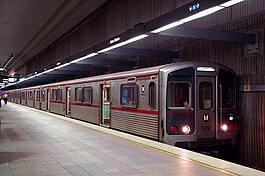
Back Línea B (Metro de Los Ángeles) Spanish خط قرمز (متروی لس آنجلس) Persian Ligne B du métro de Los Angeles French Linea B (metropolitana di Los Angeles) Italian ロサンゼルス郡都市圏交通局B線 Japanese 로스앤젤레스 메트로 B선 Korean Linia B metra w Los Angeles Polish Красная линия (метрополитен Лос-Анджелеса) Russian B Line (Los Angeles Metro) SIMPLE 洛杉矶地铁红线 WUU
| B Line | |||||||||||||||||||||||||
|---|---|---|---|---|---|---|---|---|---|---|---|---|---|---|---|---|---|---|---|---|---|---|---|---|---|
 | |||||||||||||||||||||||||
 B Line train at Union Station | |||||||||||||||||||||||||
| Overview | |||||||||||||||||||||||||
| Other name(s) | Red Line (1993–2020) | ||||||||||||||||||||||||
| Owner | Los Angeles County Metropolitan Transportation Authority | ||||||||||||||||||||||||
| Line number | 802 | ||||||||||||||||||||||||
| Termini | |||||||||||||||||||||||||
| Stations | 14 | ||||||||||||||||||||||||
| Website | metro | ||||||||||||||||||||||||
| Service | |||||||||||||||||||||||||
| Type | Rapid transit | ||||||||||||||||||||||||
| System | Los Angeles Metro Rail | ||||||||||||||||||||||||
| Depot(s) | Division 20 (Los Angeles) | ||||||||||||||||||||||||
| Rolling stock | Breda A650 or CRRC HR4000 running in 4 or 6 car consists | ||||||||||||||||||||||||
| Daily ridership | 64,729 (Weekday, May 2024) | ||||||||||||||||||||||||
| Ridership | 25,899,711[a] (2023) | ||||||||||||||||||||||||
| History | |||||||||||||||||||||||||
| Opened | January 30, 1993 | ||||||||||||||||||||||||
| Completed | June 24, 2000 | ||||||||||||||||||||||||
| Technical | |||||||||||||||||||||||||
| Line length | 14.7 miles (23.7 km)[1] | ||||||||||||||||||||||||
| Number of tracks | 2 | ||||||||||||||||||||||||
| Character | Fully underground (except yard) | ||||||||||||||||||||||||
| Track gauge | 4 ft 8+1⁄2 in (1,435 mm) standard gauge | ||||||||||||||||||||||||
| Electrification | Third rail, 750 V DC | ||||||||||||||||||||||||
| Operating speed | 70 mph (110 km/h) (max.) 33.9 mph (54.6 km/h) (avg.) | ||||||||||||||||||||||||
| |||||||||||||||||||||||||
The B Line (formerly the Red Line from 1993–2020) is a fully underground 14.7 mi (23.7 km)[1] rapid transit line operating in Los Angeles, running between North Hollywood and Downtown Los Angeles. It is one of six lines in the Los Angeles Metro Rail system, operated by the Los Angeles County Metropolitan Transportation Authority. Built in four stages between 1986 and 2000, the line cost $4.5 billion.
The B Line is one of the city's two fully-underground subway lines (along with the D Line). The two lines share tracks through Koreatown and Downtown Los Angeles. As of 2019[update], the combined B and D lines averaged 133,413 boardings per weekday.[2]
In 2020, Metro renamed all of its lines using letters and colors, with the Red Line becoming the B Line (retaining the red color in its service bullet) and the Purple Line becoming the D Line.
Cite error: There are <ref group=lower-alpha> tags or {{efn}} templates on this page, but the references will not show without a {{reflist|group=lower-alpha}} template or {{notelist}} template (see the help page).
- ^ a b "Facts At A Glance". Los Angeles County Metropolitan Transportation Authority. June 2023. Archived from the original on March 19, 2023. Retrieved June 22, 2023.
- ^ "Interactive Estimated Ridership Stats". Los Angeles County Metropolitan Transit Authority. January 1, 2020. Archived from the original on June 24, 2021. Retrieved February 10, 2020.
